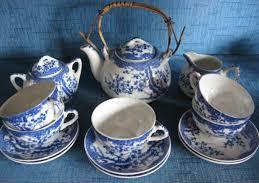 Porcelain is a type of ceramic that demands much knowledge and experience. It is baked at 1,250°C to sometimes 1,600°C, and it is not porous.
Porcelain is a type of ceramic that demands much knowledge and experience. It is baked at 1,250°C to sometimes 1,600°C, and it is not porous.
For the composition of porcelain are 2 parts of kaolin, a stiff, white clay, used mixed with 1 part silver sand (quartz) and 1 part feldspar (crushed granite).
Kaolin (Al2O3.SiO2.2H3O) is pure clay: 46% silicon, 40% aluminum and 14% water. Kao Ling is a Chinese ridge in the province of Kiangsi.
The clay is stored months in dark basements or pits to rot.
The quartz makes the mass less fat and glassy when heated.
The feldspar lowers the firing temperature.
Porcelain is hard (fired), translucent and sounds clear.
After the shaping follows a drying process of three months. Then European porcelain is fired twice, first at 900°C to biscuit. After the glazing follows smooth firing during half a day at about 1400°C. Approximately 10% of the mass is evaporated, which gives a lot of shrinkage.
The wasters fly out. Painted decorations are fired in an kiln at 600-900°C.
Clay also has, as soap, a cleansing effect which was also used in fuller's earth (see fulling mill).
Lots of info and techniques, including those from other cultures can be found in ‘The Book of Clay’, Luc Versluys.
“Carelessness is the unmarried mother of a china shop.”(Show Verhoeven)
